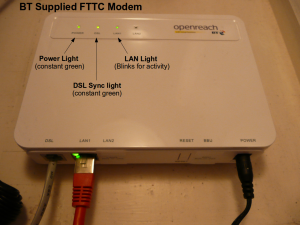FTTC Modem
Related Pages on the A&A Website:
With FTTC, BT will supply and install a VDSL modem (the Active NTE in BT speak), You will then need a PPPoE device (router or software) to use the service.
- PPPoE Service Name = Blank
- PPPoE username = as supplied, eg x@a.1
- PPPoE password = as supplied
- MTU = 1500 (if your equipment can handle baby jumbo frames and RFC 4638), otherwise 1492
- Auth Protocol CHAP
FTTC Modem
Here is an image of a BT supplied FTTC modem

The modem is supplied by BT, if it develops a fault then AAISP can contact BT and report a fault.
If the sync light flashes, then there is no sync, and will probably need to be reported as a fault.
Router Throughput
With the switch to FTTC (especially from low sync'd ADSL connections) your modem is suddenly confronted with throughput possibly 10 or even 20 times more than before!
| Router | Sync Speed | Throughput | Notes |
| Linksys WRTU54G-TM | 24Mb | ~18Mb/sec | Running OpenWRT trunk from here. Disconnected PPP due to link saturation at default settings - adjust PPP options for stability |
| Netgear WNR854T | 24Mb | 24Mb | Running OpenWRT 10.03 (Backfire). Probably capable of more - have asked BT to move cabinet closer, but they seem unwilling! |
| FireBrick 2700 | 16Mb | 16Mb | It should be able to handle around 350Mb/s! |
Notes:
- Green throughput - not bottleneck on connection
- Red throughput - bottleneck on connection
Billion 7800 Notes
The Billion 7800 is a popular router with our customers, but take note that when configuring the WAN side, it may need a reboot when changing the WAN type (ADSL/eWAN), and then a reboot when changing the WAN Profile.
FireBrick 2700
The Firebrick 2700 is a great router for FTTC, and even bonding FTTC. See the FireBrick pages for more info
Testing and using FTTC with just a computer
You can connect a computer to the FTTC modem directly, and use PPPoE to make a connection to get online. This is good for testing the FTTC modem with a device other than your normal router.
Windows
- Control panel, Network and Internet
- Click Network Sharing Centre
- Click Setup a connection or network
- Follow the wizard
- You should be online, you may want to check firewall settings
Remember to keep the service name blank
OSX (Apple)
- Go to System Preferences, Network
- Click the + icon on the bottom/right (you may need to click the unlock icon first)
- Interface=PPPoE, Ethernet=Ethernet, Service Name=AAISP
- Then will in the account name and password, click Connect (keep service name blank)
- You should be online, you may want to check firewall settings
RFC 4638 Information
Some pointers regarding RFC 4638, PPPoE and Linux-based routers.
- The wan interface needs to be set to an MTU of 1508 on the assumption that there needs to be room for the 1500 mtu PPP package on the way to the modem (1500 may work - untested though).
- You will require the unreleased ppp 2.4.6. In testing, ppp 2.4.5 with the rp-pppoe plugin updated to the latest version seems to work, although a recompile will be necessary. This can be fetched from ppp's website / git.
- Using ppp's debug option will allow you to see the rp-pppoe plugin negotiating a PPP-Max-Payload option with the BRAS via a PPPoE option. If this isn't seen, then your MTU is forced back to 1492.
RFC 4638 on OpenWRT 10.03.1 (Backfire)
Getting RFC4638 on Backfire is somewhat tricky, but do-able if you're feeling like fiddling with code! In order to make it work:
- Look on your router and get hold of the complete ppp command line from the output of htop or /proc/(process id)/cmdline and save it somewhere.
- create an OpenWRT build environment for the 10.03.1 release so you can compile the new pppd release
- adapt the pppd 2.4.4 package definition to pull the 2.4.5 package from ftp.samba.org instead - you will need to update the version to 2.4.5 and the md5sum of the downloaded package.
- Pull the ppp 2.4.5 package patches from the (currently) "trunk" release and replace the 2.4.4 patches with these. The 2.4.4 patches are too outdated to apply to ppp 2.4.5.
- Use OpenWRT's patch making ability to create a patch that applies to 2.4.5 to update rp-pppoe to the latest release. The process is to create a new patch point in the build_root using quilt (see OpenWRT's wiki - surprisingly easy and well documented!), overwrite the 2.4.5 rp-pppoe plugin with the git version (ugly but it works...) and then generate a new patch to reflect the differences.
- Re-compile the ppp package to create an installable .pkg. This is why you created a patch - the OpenWRT compile routine will wipe out any changes you make to the build_root.
- Use SCP to copy the new ppp and ppp-mod-pppoe packges to your router's /tmp
- Install the updated packages with opkg on your router.
- Adjust yout /etc/config/network so that the MTU is now 1508
- Add the debug option to /etc/ppp/options
- Issue an ifup wan
- Have a look at the output of logread and watch what happens
- Check your interfaces with ifconfig
- Check clueless to see if it sees your mru 1500
If you find after this that you can't start pppd (it doesn't show up in the ps list after you ifup wan, then run the command you saved at the start to run it and see if any errors are generated.